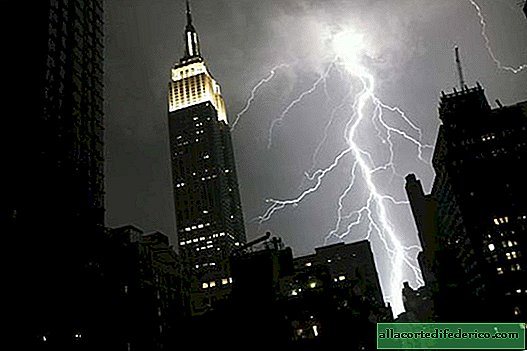7 major lightning myths
Thunderstorms at all times scared people. And the matter is not only in the roar, which was published by the chariot of Thor or the angry Zeus. The powerful electric discharges that occur in the sky, often fraught with mortal danger. People have made many assumptions about how to behave during a thunderstorm and what properties lightning has. Unfortunately, scientists have proven that many of them turned out to be myths.
Myth 1: Lightning never hits the same place twice
Perhaps the most common myth, which, however, is not confirmed by practice. Lightning can strike any time anywhere. One of the clearest evidence is the Empire State Building in Manhattan. The skyscraper was once used as a laboratory of lightning because of its ability to attract electricity. The building is struck by lightning somewhere from 25 to 100 times a year, and sometimes several times during a thunderstorm.

Photo: GREGORY KRAMER / GETTY IMAGES
By the way, tall buildings themselves can generate lightning. During a thunderstorm, objects on earth have an electric charge opposite to the charge in the cloud. While most lightning strikes from the cloud into the ground, occasionally they can strike from the bottom up - from tall buildings and antennas, when the electric charges in the clouds change rapidly.
Myth 2: Lightning is only dangerous in the rain.
Usually people begin to seek shelter from lightning when the first drops of rain from a thundercloud fall on them. However, lightning can strike the ground far beyond a thunderstorm.

Photo: LYLE LEDUC / GETTY IMAGES
Usually this distance is 5 km. However, there are facts when lightning appeared in the literal sense of the word like thunder from a clear sky, while the nearest thundercloud was at a distance of 40, and sometimes even up to 80 km.
Myth 3: Headphones make you an ideal target for lightning.
"Do not use gadgets during a thunderstorm! They attract lightning," - how many times have we heard this warning. But the facts suggest otherwise. The same example of the Empire State Building proves that lightning attracts objects that are very high. Therefore, if you are at an altitude of less than 30 meters above the ground, headphones will not increase your chances of becoming a target for lightning.

On the contrary: a headphone cable can help you divert electrical discharge from your heart. But this will not save you from major burns, so you should not be on the roofs of high-rise buildings even with headphones during a thunderstorm.
Myth 4: You are absolutely protected at home.
Of course, your home is your castle, but even in it you need to beware of lightning. Ideally, during a thunderstorm, you should be as far from windows and doors as possible. Another good idea is to turn off electrical appliances and landlines. Without a computer, TV or hairdryer, you can live a couple of hours.

Photo: ADRIAN ASSALVE / GETTY IMAGES
By the way, internal plumbing, metal window and door frames are effective lightning rods that can increase safety during a thunderstorm. Only a shower at this time is better not to use.
Myth 5: If lightning strikes a person, he may shock you
If you saw a lightning strike someone, it is quite natural to assume that it is dangerous to touch a person: suddenly an electric charge will also pass through you. In fact, this is not so, and the human body affected by lightning does not store electricity.

Photo: PARAMOUNT PICTURES / FOTOS INTERNATIONAL / GETTY IMAGES
So you can safely provide first aid! Although a lightning strike can lead to cardiac arrest, burns and nerve damage, most victims can survive if they receive the necessary medical attention.
Myth 6: If you hit a thunderstorm on the street, it’s safer to lie on the ground.
We already know that during a thunderstorm, the higher the more dangerous. The logical conclusion from this would be the decision to lie on the ground and stretch out on it - much lower? Especially if it happens in an open field. But not so simple.

Photo: TBOYAN / GETTY IMAGES
When lightning strikes the earth in an open area, it can send electric current up to 30 meters across the surface. And if you lie on the ground, then electricity can hit your whole body.
Therefore, experts advise another option: squat down, bending your head to your knees, and hold your ears in your hands. In this case, you are at the same time as low as possible to the ground, but you touch the ground itself minimally. True, it is worth remembering that this is an extreme way to protect yourself from lightning if there is no normal shelter nearby.
Myth 7: Rubber tires can protect you.
Speaking of shelters. A car can really be a convenient place to ride out a thunderstorm (although the house is still better). But the safety inside the passenger compartment ensures the vehicle is closed: you will not get wet in it. But rubber tires, which supposedly can save from electric discharge, are completely useless.

The same, incidentally, applies to rubber soles of shoes. Rubber, of course, can protect against electricity. But this does not apply to a layer of a couple of centimeters on car tires or even less on sneakers.
Based on materials from HowStuffWorks.com

















